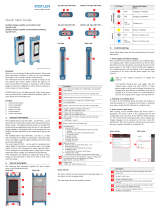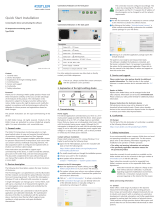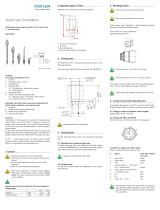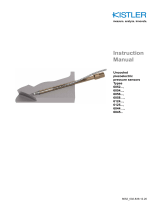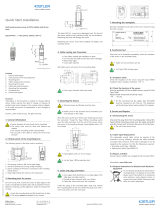Page is loading ...

Instruction
manual
Cylinder pressure
sensor
Type 6634A1
6634A1_002-993e-09.21


Foreword
6634A1_002-993e-09.21 Page 1
Foreword
Thank you for choosing a Kistler quality product
characterized by technical innovation, precision and long
life.
Information in this document is subject to change without
notice. Kistler reserves the right to change or improve its
products and make changes in the content without
obligation to notify any person or organization of such
changes or improvements.
© 2021 Kistler Group. Kistler Group products are protec-
ted by various intellectual property rights. For more
details visit www.kistler.com. The Kistler Group includes
Kistler Holding AG and all its subsidiaries in Europe,
Asia, the Americas and Australia.
Kistler Group
Eulachstraße 22
8408 Winterthur
Switzerland
Tel. +41 52 224 11 11
www.kistler.com

Content
Page 2 6634A1_002-993e-09.21
Content
1.Introduction .................................................................................................................................. 3
2.Important information ................................................................................................................. 4
2.1Protection and standards .................................................................................................... 4
2.2Precautions ......................................................................................................................... 5
2.3Disposal ............................................................................................................................... 5
2.4Disposal Instructions for electrical and electronic equipment ............................................. 5
3.Description ................................................................................................................................... 6
3.1Introduction ......................................................................................................................... 6
3.2Dimensions Type 6634A1 ................................................................................................... 7
5.3 Working principle ................................................................................................................. 8
4.Installation .................................................................................................................................... 9
4.1General ................................................................................................................................ 9
4.2Recommended mounting .................................................................................................... 9
4.2.1Sealing ................................................................................................................. 10
4.2.2Installing the sensor ............................................................................................. 10
4.2.3Installing the charge amplifier .............................................................................. 10
4.2.4Cable between charge amplifier and data acquisition unit ................................... 10
4.2.5Electric block diagram .......................................................................................... 11
4.2.6Bandwidth as function of load capacity ................................................................ 11
4.2.7Sensitivity error as a function of load resistance (Input ECU).............................. 11
4.2.8Pin Allocation ........................................................................................................ 12
4.2.9Mounting tools ...................................................................................................... 12
4.2.10Accessories .......................................................................................................... 12
5.Operation .................................................................................................................................... 13
6.Maintenance ............................................................................................................................... 14
7.Trouble shooting ....................................................................................................................... 15
7.1Repair ................................................................................................................................ 15
7.2Detection of sensor failures ............................................................................................... 15
7.2.1During the power-up period of the sensor (≈ 100s) ............................................. 15
7.2.2After the sensor power-up period of 100s (engine not running) .......................... 15
7.2.3During engine is running ...................................................................................... 16
7.3Working limits of sensor signal ......................................................................................... 16
8.Declaration of conformity ......................................................................................................... 17
Total pages 17

Introduction
6634A1_002-993e-09.21 Page 3
1. Introduction
Please take the time to thoroughly read this instruction
manual. It will help you with the installation, maintenance,
and use of this product.
To the extent permitted by law Kistler does not accept
any liability if this instruction manual is not followed or
products other than those listed under Accessories are
used.
Kistler offers a wide range of products for use in
measuring technology:
Piezoelectric sensors for measuring force, torque,
strain, pressure, acceleration, shock, vibration and
acoustic-emission
Strain gage sensor systems for measuring force and
torque
Piezoresistive pressure sensors
Signal conditioners, indicators and calibrators
Electronic control and monitoring systems as well as
software for specific measurement applications
Data transmission modules (telemetry)
Kistler also develops and produces measuring solutions
for the application fields engines, vehicles, manufac-
turing, plastics and biomechanics sectors.
Our product and application brochures will provide you
with an overview of our product range. Detailed data
sheets are available for almost all products.
If you need additional help beyond what can be found
either on-line or in this manual, please contact Kistler's
extensive support organization.

Cylinder pressure sensor, Type 6634A1
Page 4 6634A1_002-993e-09.21
2. Important information
It is essential to review the following information, which is
intended to ensure your personal safety when working
with cylinder pressure sensors.
To the extent permitted by law Kistler accepts no liability
if this instruction manual is not followed.
2.1 Protection and standards
All equipment is tested and has left the factory in a
perfect, safe condition. In order to maintain this
condition and ensure safe operation, compliance is
required with the instructions and warning notes
contained within this manual or imprinted on the
product itself.
The instruments are CE-compliant within the meaning of:
ISO 9001
2011/65/EU (ROHS)
2014/30/EU (EMC)
The sensor conforms to EC Standard 2004/108/EC and
meets EMC standards. Additionally the following
requirements are met:
EMC Emission
EN 61000-6-3:2007 + A1:2011
EN 61000-6-4:2007 + A1:2011
EN 61326-1:2013 (Class A+B equipment)
EMC Immunity
EN 61000-6-1:2007
EN 61000-6-2:2005
EN 61326-1:2013 (Class A+B equipment)
Complies with the following normatives:
general regulations
EN 60079-0:2012+A11:2013 / IEC 60079-0:2011
EN 60079-15:2010 / IEC 60079-15:2010
Compliance with local safety regulations, which may
apply to the use of power line operated electrical and
electronic equipment, is strongly recommended.

Important info
6634A1_002-993e-09.21 Page 5
2.2 Precautions
Compliance with the following precautionary
measures is vital to ensure safe and reliable
operation:
The equipment should be used only under the
specified operating conditions.
If there is evidence that safe operation is no longer
possible, the instrument must be powered off and
rendered safe against accidental start-up.
Safe operation is no longer possible when the product
• shows visible signs of damage
• is no longer operating
• has been subjected to prolonged storage under
unsuitable conditions
2.3 Disposal
Dispose of packaging and worn components in accor-
dance with the regulations in force in the country in which
the cylinder pressure sensor is installed.
2.4 Disposal Instructions for electrical and electronic equipment
Do not discard old electronic instruments in municipal
trash. For disposal at end of life, please return this
product to an authorized local electronic waste
disposal service or contact the nearest Kistler
Instrument sales office for return instructions.

Cylinder pressure sensor, Type 6634A1
Page 6 6634A1_002-993e-09.21
3. Description
3.1 Introduction
The cylinder pressure sensor consisting of a life time
optimized piezoelectric pressure sensor linked by a
robust fluoropolymer cable to a charge amplifier. The
rugged design and high temperature resistance enables
reliable knock detection. The good linearity and stability
of the sensors ensures reliable and repeatable
measurements over a long period of time. The charge
amplifier provides a galvanic isolated three wire type
voltage output.
The integrated charge amplifier provides a voltage output
signal in a range of 0.2 … 4.8 V. The sensor has a zero
line of about 1.2 V (at dynamic pressure 0 bar). The
output is AC-coupled, therefore static pressure
measurements are not possible.

Description
6634A1_002-993e-09.21 Page 7
3.2 Dimensions Type 6634A1
Type
Cable length [mm]
6634
A
1 1000
Fig. 1 Dimensions of Types 6634A1
cable length see table

Cylinder pressure sensor, Type 6634A1
Page 8 6634A1_002-993e-09.21
5.3 Working principle
The cylinder pressure is acting on the diaphragm. The
diaphragm converts the pressure in a proportional force
which is transmitted on the sensor element. The
piezoelectric sensor element converts the force into an
electrical charge. The electrical charge is converted by a
charge amplifier into a voltage signal.
The complete cylinder pressure sensor is designed for
easy operation and very long life time.
The advantages of the piezoelectric principle are:
Operates safely up to high temperatures and is
therefore ideally suited for accurate measurements in
harsh conditions
Very small sensitivity change over temperature range
High stiffness, results in small diaphragm stress
High reproducibility since the piezoelectric constant
of the measuring element is a constant of the
material and does not change over time
Fig 2: Schematic cross section of sensor element

Installation
6634A1_002-993e-09.21 Page 9
4. Installation
4.1 General
The quality of the measurement and the sensor life time
depend very much on the correct mounting of the sensor.
The mounting hole must be manufactured within the
tolerances
Avoid mounting at the end of long tubes, it creates
gas acoustic resonance and overheating of the
sensor
Ideal sensor mounting bore in the cylinder head has
ca. 10 … 15 mm distance from the combustion
chamber
Sensor must be tightened according the mounting
torque of 15 Nꞏm
In case of questions regarding the installation, please
contact Kistler.
4.2 Recommended mounting
Fig. 3: Mounting bore for shoulder sealing
Mounting torque: 15 ±1 Nꞏm

Cylinder pressure sensor, Type 6634A1
Page 10 6634A1_002-993e-09.21
4.2.1 Sealing
A leak proof mounting of the sensor is essential to
prevent overheating of the sensor by leaking hot gases.
Good sealing is obtained by
fine-machined sealing surface on the engine (for
surface roughness and angularity please consult the
data sheet)
all sealing surfaces (on engine and on sensor) must
be clean and free of any burrs (e.g. combustion
residuals, soot, etc.)
4.2.2 Installing the sensor
Clean all parts and apply a light film of grease to the thread
and the sealing surface. Use high-temperature paste
MoS2 (e.g. Molycote P74 or 1 000) or copper grease.
Install the sensor into mounting bore with a torque of
15 Nꞏm.
Use a torque wrench for installing the sensor. After
installing the sensor, check that there is no gas leakage
when engine runs on idle speed.
4.2.3 Installing the charge amplifier
Charge amplifier can be fixed with cable strips in the
cable channel. Select a location where the temperature
definitely does not exceed 120 °C. Route and fix the
integrated cable between sensor and charge amplifier so
that it is protected against mechanical damage. Keep it
away from any source of heat such as the exhaust or hot
fuel lines.
4.2.4 Cable between charge amplifier and data acquisition unit
Use a shielded cable, otherwise the sensor does not
comply with the CE directives.
The cable shield should only be connected on sensor
side via the M12 plug (do not connect cable shield at the
ECU side).
The power supply for the sensor should be floating, -Exct
must not be connected to ECU housing.
If the cable shield and/or ground (-Exct) are connected to
the ECU housing, the galvanic isolation is not given
anymore and disturbances in the signal can be the
consequence. In worst case the electronics can get
damaged.

Installation
6634A1_002-993e-09.21 Page 11
4.2.5 Electric block diagram
Fig. 4: Electric block diagram
4.2.6 Bandwidth as function of load capacity
High capacitive load (> 50 nF) from the cable between
the sensor and the data acquisition unit, as well as a high
input capacity of the data acquisition unit affects the
sensor bandwidth (gets < 10 kHz).
4.2.7 Sensitivity error as a function of load resistance (Input ECU)
Small input resistance of the data acquisition unit affects
the sensor sensitivity.
The additional sensitivity error as a function of the input
resistance is shown below:
R input
[kΩ]
Sensitivity error (in addition)
[%]
>1 000 < 0.01
100 0.1
10 1

Cylinder pressure sensor, Type 6634A1
Page 12 6634A1_002-993e-09.21
4.2.8 Pin Allocation
Fig. 5: Pin allocation of connector
Important
Incorrect wiring can destroy the sensor unless the
excitation current is limited to ≤ 50 mA.
4.2.9 Mounting tools
Torque wrench 8 … 40 Nm Type 1300A11
Fork wrench SW 12 for 1300A11 Type 1300A13
Tubular socket Hex 12/16, l = 350 mm Type 1300B6
4.2.10 Accessories
Dummy plug shoulder sealed Type 6442

Operation
6634A1_002-993e-09.21 Page 13
5. Operation
After starting up the engine check for any gas leakage at
once. If there is any gas leaking out, stop the engine and
rectify the mounting to achieve a complete sealing (see
chapter 4).

Cylinder pressure sensor, Type 6634A1
Page 14 6634A1_002-993e-09.21
6. Maintenance
After installation, the sensor needs no maintenance. Do
not use a steam or high-pressure cleaner for cleaning
purposes.

Trouble shooting
6634A1_002-993e-09.21 Page 15
7. Trouble shooting
In case the sensor does not give a proper output signal,
please disconnect the cable for a couple of seconds and
connect it again.
The amplifier works with a so-called time constant to
ensure a reliable signal without drift. Due to the time
constant, the sensor may be out of range for a short
period of time after powering up. It may take 1 … 2
minutes until the signal is within the specified range.
7.1 Repair
The sensor cannot be repaired on site. It must be
returned to factory, in case of incorrect function or
damaged parts.
7.2 Detection of sensor failures
Detection of sensor failures must be handled differently
during the sensor power-up period and during the regular
operation after the power-up period.
7.2.1 During the power-up period of the sensor (≈ 100s)
No failure detection possible
7.2.2 After the sensor power-up period of 100s (engine not running)
Nominal value: Signal output = 1.1 … 1.3 V
Failure mode: Signal output = 0 V
Possible error causes:
No power supply from the ECU to the charge amplifier
Incorrect wiring between the ECU and the charge
amplifier
Short circuit between Signal output and GND
Charge amplifier electronics defect

Cylinder pressure sensor, Type 6634A1
Page 16 6634A1_002-993e-09.21
Failure mode: Zero line > 1.3 V (engine not running, constant value)
Possible error causes:
Low electrical insulation (<106 Ohm) in the sensor or in
the cable between the sensor and the charge amplifier
(due to e.g. overheating of the sensor)
Charge amplifier electronics temperature > 120 °C
Charge amplifier electronics defect
7.2.3 During engine is running
Failure mode: Signal output ≈ 1.2 V (constant nominal zero line)
Possible error causes:
Engine not running
Sensor broken (open circuit)
Broken cable between the sensor and the charge
amplifier (open circuit)
Charge amplifier electronics defect
Failure mode: Signal output is clipping (0.2 V > Uout > 4.8 V)
Possible error causes:
Engine is knocking
Fast load changes occur
Low electrical insulation (<106 Ohm) in the sensor or in
the cable between the sensor and the charge amplifier
(due to e.g. overheating of the sensor)
Charge amplifier electronics defect
Failure mode: Sensor sensitivity / phase out of specification
Possible error causes:
Sensor broken / damaged (sometimes not visible)
Charge amplifier electronics defect
=> detection only possible with SW intelligence in
ECU
7.3 Working limits of sensor signal
After the sensor power-up period of 100s (5 * time
constant)
Lower limit 0.4 V
The zero line may temporarily slide down to 0.4 V during
the engine start, engine stop and fast load changes
Upper limit 5.1 V
The signal output may temporarily reach up to 5.1 V
during knocking events

Declaration of con
6634A1_002-993e-09.21 Page 17
8. Declaration of conformity
/

